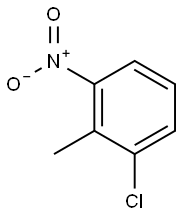| Identification | More | [Name]
2-Chloro-6-nitrotoluene | [CAS]
83-42-1 | [Synonyms]
1-CHLORO-2-METHYL-3-NITROBENZENE
2-CHLORO-6-NITROTOLUENE
2-NITRO-6-CHLOROTOLUENE
3-CHLORO-2-METHYLNITROBENZENE
6-CHLORO-2-NITRO TOLUENE
1-chloro-2-methyl-3-nitro-benzen
2-chloro-6-nitro-toluen
6,2-Chloronitrotoluene
Benzene,1-chloro-2-methyl-3-nitro-
Toluene, 2-chloro-6-nitro-
2-Chloro-6-Nitotoluene
6-Chloro-2-Nitrotoluene,>98%
2-Chloro-6-nitrotoluene 98+%
2-METHYL-3-CHLORONITROBENZENE
2-chluoro-6-nitrotoluene
6-Nitro-2-chlorotoluene | [EINECS(EC#)]
201-475-9 | [Molecular Formula]
C7H6ClNO2 | [MDL Number]
MFCD00007205 | [Molecular Weight]
171.58 | [MOL File]
83-42-1.mol |
| Safety Data | Back Directory | [Hazard Codes ]
Xn,Xi,N | [Risk Statements ]
R22:Harmful if swallowed.
R36/37/38:Irritating to eyes, respiratory system and skin .
R20/21/22:Harmful by inhalation, in contact with skin and if swallowed .
R52/53:Harmful to aquatic organisms, may cause long-term adverse effects in the aquatic environment . | [Safety Statements ]
S36/37/39:Wear suitable protective clothing, gloves and eye/face protection .
S26:In case of contact with eyes, rinse immediately with plenty of water and seek medical advice .
S61:Avoid release to the environment. Refer to special instructions safety data sheet . | [RIDADR ]
UN 3457 6.1/PG 3
| [WGK Germany ]
3
| [RTECS ]
XS9130000
| [Hazard Note ]
Irritant | [TSCA ]
Yes | [HazardClass ]
6.1 | [PackingGroup ]
III | [HS Code ]
29039990 |
| Questions And Answer | Back Directory | [Photodissociation]
Photodissociation of 2-chloro-6-nitrotoluene (ClNT) at 193, 248 and 266 nm and nitrocyclopentane (NCP) at 193 nm leads to the formation of OH, as detected by laser-induced fluorescence (LIF). The nascent OH produced from the photolysis of ClNT at all the wavelengths is vibrationally cold, with the Boltzmann type rotational state distributions. However, the nascent OH product from NCP is in the ground, and vibrationally excited states with the measured average relative population in v"= 1 to that in v"= 0 of 0.12 ± 0.03, and these levels are characterized by rotational temperatures of 650 ± 180 K and 1570 ± 90 K, respectively[1].
|
| Hazard Information | Back Directory | [Chemical Properties]
yellow to light brown crystalline mass | [Uses]
2-Chloro-6-nitrotoluene is used as a reagent in the synthesis of 3-Chloro-2-methylaniline (C367805); a herbicide intermediate. | [Definition]
ChEBI: 2-chloro-6-nitrotoluene is a nitrotoluene that is toluene in which the hydrogens ortho- to the methyl group have been replaced by a chlorine and a nitro group. A low-melting (37 ℃) solid. It is a nitrotoluene, a member of monochlorobenzenes and a volatile organic compound. | [Production Methods]
Chlorination of 2-nitrotoluene, in a process similar to the chlorination of nitrobenzene, gives a mixture of 6-chloro (80 %) and 4-chloro (20 %) isomers. The major component 2-Chloro-6-nitrotoluene is separated by vacuum distillation. | [References]
[1] Monali N. Kawade. “Photodissociation dynamics of 2-chloro-6-nitrotoluene and nitrocyclopentane in gas phase: Laser-induced fluorescence detection of OH.” Chemical Physics 443 (2014): Pages 123-132.
|
|
|





